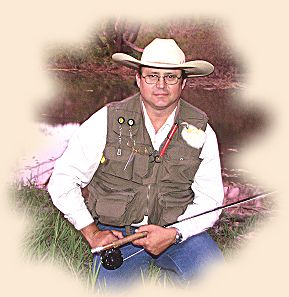Panfish or Bass, a question often posed when a day
of fishing begins on the river. Typically, my primary
focus is on panfish, more so the breams. However I've
never complained about any bass which chooses to sample
my fly. In the following parts I will do my best to
convey the Rivers, creeks, flys and methods used here
in the Texas Hill Country to produce fine catches of
panfish and bass.

First, let's talk a little about the Panfish. Pound for
pound, panfish, specifically perch can put up a strong
fight to match what you can experience with the largemouth
bass. Bluegills, Longears, Sunnies and Shellcrackers can
become quite large depending on their environment. It is
not uncommon to consistently land these feisty fish in one
to three pound range from a stock pond or large river. A
full day of catching these on five weights or less equipment
can have a tiring but satisfying affect on any flyfisher.
What makes these fish such fighters is typically a bream
will turn and put its body on a 90 degree angle to your
line tension direction. This gives it the maximum body
surface to apply the greatest force against you. This
at times, causing these little fish to seem much bigger
than they really are. A two-pound Longear will give you
a good long fight on a five weight or less. If it gets
down and cross current to your position, breaking off 4
pound or less tippet is a good possibility. I have on
numerous occasions had these fish hit a surface fly as
hard as any bass. Some have completely exited their bodies
from the water to take the fly. Other times a mild swirl
of water as the fly is sucked under.
Nymphing and streamers are also effective but totally
different approaches. Nymphing is fished much the same
way as you would for trout. With our rocky bottom rivers,
the real challenge for beginners is telling the difference
between a fish strike or just another rock pausing your
nymph as it bounces along the bottom. A slight tug on
the line will usually be enough to release the nymph from
a rock. If it happens to be a fish, this action will also
set the hook and most times your line will start moving
upstream, definitely an indication of fish.
Streamers work well cast downstream and stripped slowly
upstream. The key word here is slowly. I prefer grabbing
the line between my thumb and forefinger and pulling in an
inch or two at a time. The fish usually strike during your
pauses to grab more line.
Some of the larger bream will be out in the current near
the bottom holding behind rocks or other submerged objects
to pick up small baitfish and food moving down with the
current. This means whether using nymphs or streamers,
plan your path to pass closely to any submerged object.
Remember, for bream, keeping your hook size small will
give you more hookups. I never use anything larger than
a size 10 and most of my flys are size 12. Sometimes
the fish will swallow the fly and using barbless hooks
will greatly increase the survivability of the fish.
Circle hooks may be the most effective as the reports
I have read are very favorable.
In the next part I will be discussing the flys, places
and methods for catching these fun little fish. ~ Hillfisher
|





